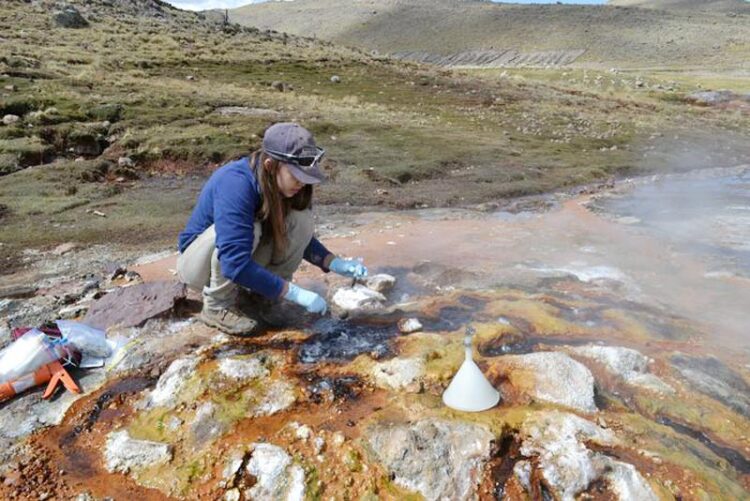Tectonics matter

Utah State University geoscientist Heather Upin collects a microbial sample from Aguas Calientas Pinaya in Peru’s southern Andes. She and USU colleague Dennis Newell published findings about microbial diversity in Peruvian hot springs.
Credit: USU/Dennis Newell
USU geoscientists probe geochemistry, microbial diversity of Peruvian hot springs.
Heather Upin, Dennis Newell report microbial community composition is distinctly different in two tectonic settings.
South America’s Andes Mountains, the world’s longest mountain range and home to some of the planet’s highest peaks, feature thousands of hot springs. Driven by plate tectonics and fueled by hot rock and fluids, these thermal discharges vary widely in geochemistry and microbial diversity.
Utah State University geoscientists, along with colleagues from Montana State University, examined 14 hot springs within the southern Andes in Peru and discovered microbial community composition is distinctly different in two tectonic settings. Dennis Newell, associate professor in USU’s Department of Geosciences, and recent USU graduate Heather Upin, MS 2020, report findings in the April 11 online issue of Nature’s Communications Earth & Environment. Their research is supported by the National Science Foundation and the Geological Society of America.
“We know tectonic processes control hot spring temperature and geochemistry, yet how this, in turn, shapes microbial community composition is poorly understood,” says Newell, USU Geosciences graduate director.
The scientists collected geochemical and 16S ribosomal RNA gene sequencing data from hot springs in regions with contrasting styles of subduction — flat-slab and back-arc — and noted similarities in pH but found differences in geochemistry and microbiology.
“Flat-slab hot springs were chemically heterogeneous, had modest surface temperatures and were dominated by members of the metabolically diverse phylum Proteobacteria,” Newell says.
In contrast, the back-arc hot springs were more geochemically homogenous, had hotter water, exhibited high concentrations of dissolved metals and gases, and were home to heat-loving archaeal and bacterial organisms.
“These results tell us tectonics matter when it comes microbial community make-up, but little research has been conducted around the world to demonstrate this,” Newell says.
Further investigation, with efficient genomic research, at sites around the globe could reveal how microbes have evolved in tectonically diverse environments, he says.
Journal: Communications Earth & Environment
DOI: 10.1038/s43247-023-00787-5
Method of Research: Data/statistical analysis
Subject of Research: Not applicable
Article Title: Tectonic settings influence the geochemical and microbial diversity of Peru hot springs
Article Publication Date: 11-Apr-2023
COI Statement: The authors declare no competing interests.
All latest news from the category: Earth Sciences
Earth Sciences (also referred to as Geosciences), which deals with basic issues surrounding our planet, plays a vital role in the area of energy and raw materials supply.
Earth Sciences comprises subjects such as geology, geography, geological informatics, paleontology, mineralogy, petrography, crystallography, geophysics, geodesy, glaciology, cartography, photogrammetry, meteorology and seismology, early-warning systems, earthquake research and polar research.
Newest articles

NASA: Mystery of life’s handedness deepens
The mystery of why life uses molecules with specific orientations has deepened with a NASA-funded discovery that RNA — a key molecule thought to have potentially held the instructions for…

What are the effects of historic lithium mining on water quality?
Study reveals low levels of common contaminants but high levels of other elements in waters associated with an abandoned lithium mine. Lithium ore and mining waste from a historic lithium…

Quantum-inspired design boosts efficiency of heat-to-electricity conversion
Rice engineers take unconventional route to improving thermophotovoltaic systems. Researchers at Rice University have found a new way to improve a key element of thermophotovoltaic (TPV) systems, which convert heat…



